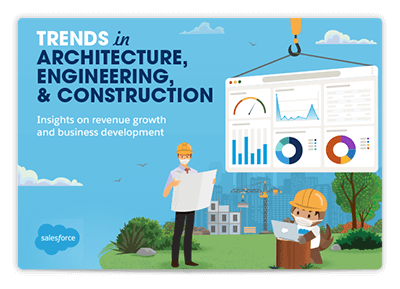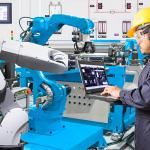Construction trends in 2023 reveal a landscape in flux for equipment manufacturers. Demand is difficult to predict. New technologies promise to reimagine how we create. And stricter regulations mean that industry players will increasingly focus on sustainability. However, there’s one thing that won’t change: our desire to keep building the future we imagine.
Let’s take a look at how today’s construction equipment industry is evolving – and what it might look like tomorrow.
Trends in Architecture, Engineering, & Construction
Eighty-four percent of those working in business development for construction firms have had to adapt quickly to new ways of selling.

5 building trends reimagining our future
1. Digital transformation is finally taking hold
Historically, the construction equipment industry has been a laggard when it comes to digitisation, but that’s starting to change. Digitisation is now the second highest priority for CE (Construction Equipment) leaders after sustainability, and 76% of AEC (architecture, construction and engineering) development professionals say that their organisation has accelerated its digital transformation. The three tools that have gained the most value since 2019 are video conferencing tools, sales forecasting tools and CRM (Customer Relationship Management) systems.
End-to-end digitisation is empowering CE operators to streamline their operations, drive productivity and get the most out of their resources. At the same time, digital channels and a focus on eCommerce are creating new ways for these businesses to connect with customers.
Despite this, there’s still work to do. 58% of AEC business development professionals say that prioritising leads is still primarily manual at their firms. And 51% say that they spend too much time manually logging activities like emails and phone calls, which hampers their overall productivity.
2. The equipment rental market is evolving
The rental market is predicted to account for 30-40% of total revenue for construction equipment firms over the next 4-5 years. Contractor preference for renting is increasing, as firms look to minimise cash expenditures, lower maintenance costs and eliminate expensive repairs.
The rental market has become more customer-centric, as a simplified rental experience and increased operational efficiency have become priorities. Rental agreements also include stipulations for on-site maintenance, repair and replacement.
3. Changing customer demands require dynamic capabilities
Economic headwinds have made it more difficult for firms to project revenue, as some opportunities have receded as new ones emerge. Now, firms need to find the right balance between exploration and exploitation to maximise their potential in an uncertain climate.
The State of Sales survey shows that only 12% of professionals are completely confident in their business development organisation’s ability to close deals in the current climate, and only 18% in their organisation’s agility. Overall, less than half (49%) of AEC business development professionals say their organisation is mostly or completely capable of adapting its structure to changing social or economic conditions.
The reluctance to use new technology internally may be partly to blame for the lack of confidence in sales and organisational agility. While the pace of digital adoption is on the rise in CE overall, that doesn’t carry over to sales.
- AEC firms’ adoption of sales forecasting tools is 25% less than other industries.
- Its adoption of sales prospecting tools is 24% less.
- Its adoption of customer insight tools is 27% less.
- Its adoption of sales process automation is 28% less.
4. A confluence of disruptive technologies promises exciting new possibilities
Automation, electrification and connectivity will drive technological change in the industry. A shift towards electric powertrains is coming, with bigger penetration in the smaller compact equipment segment.
Near-term use cases for connectivity include location tracking/anti-theft, tracking fuel and operator behaviour, and fleet optimisation and management. Longer-term cases include spare-part marketplaces, peer-to-peer rentals and uptime or output contracts.
When it comes to automation, autonomous vehicles will enable CE firms to improve safety, address internal skills gaps and optimise labour costs.
In addition to these three emerging technologies, we can also expect to see a rise in artificial intelligence. In fact, the use of AI is projected to grow 183% over the next two years among AEC business development teams. If it seems counterintuitive to invest in technology in a downturn, AI’s ability to help firms optimise their processes and eliminate inefficiencies can help streamline operations in a smart, impactful way.
5. New business models are emerging
Digitisation has unlocked a wealth of new business models, such as fuel optimisation, uptime contracts and equipment tracking software, as well as new players. For example, online equipment rental marketplaces and pureplay marketplaces are on the rise.
Firms are also increasingly relying on open innovation models. They’re turning to their suppliers, customers and competitors to identify new opportunities and technologies, rather than operating in the traditional closed model.
By focusing on innovation and looking outside the box for solutions, many firms will find imaginative solutions to age-old problems.
How today’s firms are building a digital future
Building trends show that construction is adapting to a digital-first world.
Volvo Construction Equipment used digital solutions from Salesforce to transform the customer experience across channels, while Dupont used Einstein Analytics to deliver cross-departmental insights.
Caterpillar leveraged a suite of Salesforce tools, including Service Cloud, Marketing Cloud and the Salesforce Platform to improve agility and responsiveness. Rapid analytics helped it deliver timely, relevant recommendations, enabling it to better meet the needs of its dealerships and customers. Meanwhile, construction giant Hilti rolled out Customer 360 at an incredibly fast pace during the pandemic, enabling it to get a complete view of its customers – just when they needed it most.
Fast. Innovative. Sustainable. Forward-thinking. Data-driven. Agile. These are not words that have traditionally been used to describe the construction equipment industry. But construction trends in 2023 show that things are changing. For many CE manufacturers, digitisation is transforming the landscape – and how we build on it.
To see more about how Salesforce can help you keep up with building trends, check out this Webinar of our global Construction and Infrastructure Summit.
Trends in Architecture, Engineering, & Construction
Eighty-four percent of those working in business development for construction firms have had to adapt quickly to new ways of selling.





















